Babe Ruth & Lou Gehrig Autographed Baseball Authenticated
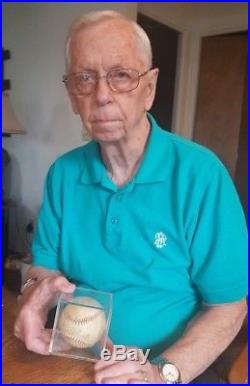
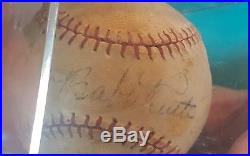
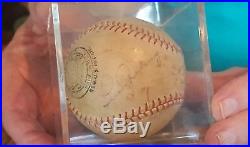
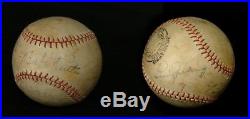
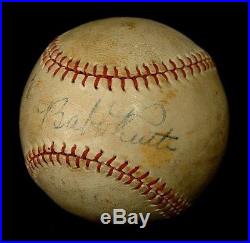
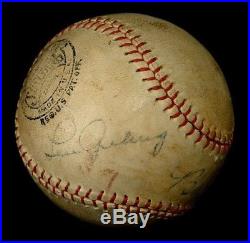
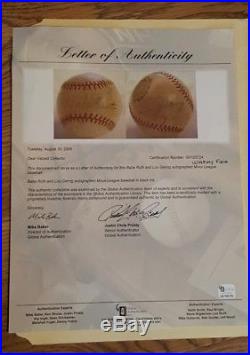
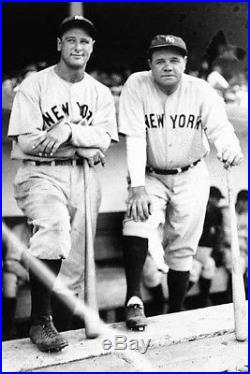
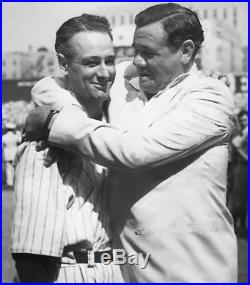
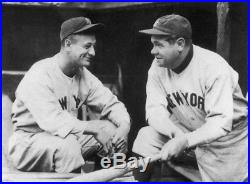
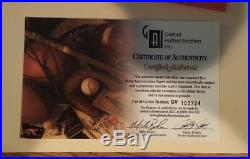


Babe Ruth & Lou Gehrig. Don Johnson's father got this ball signed in person at Wrigley Field in the late 1930's. Don was only 14 years old when his Dad gave it to him, and it has been in Don's continuous ownership ever since. From Wikipedia, the free encyclopedia. This article is about the baseball player.
For other uses, see Babe Ruth (disambiguation). Born: February 6, 1895 Baltimore, Maryland.
Died: August 16, 1948 (aged 53) Manhattan, New York. July 11, 1914, for the Boston Red Sox. May 30, 1935, for the Boston Braves.
12× AL home run leader. Boston Red Sox Hall of Fame.
Major League Baseball All-Century Team. Major League Baseball All-Time Team. Other career achievements and records.
George Herman " Babe " Ruth Jr. (February 6, 1895 August 16, 1948) was an American professional baseball. Player whose career in Major League Baseball. (MLB)ned 22 seasons, from 1914 through 1935. Nicknamed " The Bambino " and " The Sultan of Swat ", he began his MLB career as a stellar left-handed pitcher.
For the Boston Red Sox. But achieved his greatest fame as a slugging outfielder.
For the New York Yankees. Ruth established many MLB batting (and some pitching) records, including career home runs. (RBIs) (2,213), bases on balls. 690, and on-base plus slugging.
(OPS) (1.164); the latter two still stand as of 2018. Ruth is regarded as one of the greatest sports heroes in American culture. And is considered by many to be the greatest baseball player of all time.
Ruth was elected into the Baseball Hall of Fame. As one of its "first five". At age seven, Ruth was sent to St. Mary's Industrial School for Boys. Where he learned life lessons and baseball skills from Brother Matthias Boutlier of the Xaverian Brothers.
The school's disciplinarian and a capable baseball player. In 1914, Ruth was signed to play minor-league. Baseball for the Baltimore Orioles. By 1916, he had built a reputation as an outstanding pitcher who sometimes hit long home runs, a feat unusual for any player in the pre-1920 dead-ball era. 23 games in a season as a pitcher and was a member of three World Series. Championship teams with the Red Sox, he wanted to play every day and was allowed to convert to an outfielder. With regular playing time, he broke the MLB single-season home run record. After that season, Red Sox owner Harry Frazee. The trade fueled Boston's subsequent 86 year championship drought and popularized the Curse of the Bambino. In his 15 years with the Yankees, Ruth helped the team win seven American League (AL) pennants. And four World Series championships. His big swing led to escalating home run totals that not only drew fans to the ballpark and boosted the sport's popularity but also helped usher in baseball's live-ball era. Which evolved from a low-scoring game of strategy to a sport where the home run was a major factor. As part of the Yankees' vaunted Murderers' Row. Lineup of 1927, Ruth hit 60 home runs, which extended his MLB single-season record by a single home run.Ruth's last season with the Yankees was 1934; he retired from the game the following year, after a short stint with the Boston Braves. During his career, Ruth led the AL in home runs during a season twelve times. Ruth's legendary power and charismatic personality made him a larger-than-life figure during the Roaring Twenties. During his career, he was the target of intense press and public attention for his baseball exploits and off-field penchants for drinking and womanizing. His often reckless lifestyle was tempered by his willingness to do good by visiting children at hospitals and orphanages.
After his retirement as a player, he was denied the opportunity to manage a major league club, most likely due to poor behavior during parts of his playing career. In his final years, Ruth made many public appearances, especially in support of American efforts in World War II.
In 1946, he became ill with esophageal cancer. And died two years later as a result of the disease. Babe Ruth's birthplace in Baltimore, Maryland is now a museum. Was born in 1895 at 216 Emory Street in the Pigtown.Ruth's parents, George Herman Ruth Sr. And Katherine Schamberger, were both of German ancestry.
According to the 1880 census, his parents were born in Maryland. His paternal grandparents were from Prussia and Hanover. Worked a series of jobs that included lightning rod. The elder Ruth then became a counterman in a family-owned combination grocery and saloon business on Frederick Street.Was born in the house of his maternal grandfather, Pius Schamberger, a German immigrant and trade unionist. Only one of young George's seven siblings, his younger sister Mamie, survived infancy. Many details of Ruth's childhood are unknown, including the date of his parents' marriage. As a child, Ruth spoke German.
When young George was a toddler, the family moved to 339 South Woodyear Street, not far from the rail yards; by the time the boy was 6, his father had a saloon with an upstairs apartment at 426 West Camden Street. Details are equally scanty about why young George was sent at the age of 7 to St. The school's influence remained with Ruth in other ways. He was a lifelong Catholic.
Who would sometimes attend Mass after carousing all night, and he became a well-known member of the Knights of Columbus. He would visit orphanages, schools, and hospitals throughout his life, often avoiding publicity. He was generous to St.With the World Series over, Ruth gained exemption from the war draft by accepting a nominal position with a Pennsylvania steel mill. Many industrial establishments took pride in their baseball teams and sought to hire major leaguers. The end of the war in November set Ruth free to play baseball without such contrivances. During the 1919 season, Ruth was used as a pitcher in only 17 of his 130 games. And compiled an 85 record.
Barrow used him as a pitcher mostly in the early part of the season, when the Red Sox manager still had hopes of a second consecutive pennant. By late June, the Red Sox were clearly out of the race, and Barrow had no objection to Ruth concentrating on his hitting, if only because it drew people to the ballpark. Ruth had hit a home run against the Yankees on Opening Day, and another during a month-long batting slump that soon followed. Even his failures were seen as majesticone sportswriter noted, When Ruth misses a swipe at the ball, the stands, the stands would quiver. Large crowds jammed stadiums to see Ruth play when the Yankees were on the road.
How Does He Do It? Cartoon, presidential candidates Warren G.Wonder at Ruth's record home run pace. The home runs kept on coming.
Ruth tied his own record of 29 on July 15 and broke it with home runs in both games of a doubleheader four days later. By the end of July, he had 37, but his pace slackened somewhat after that. Nevertheless, on September 4, he both tied and broke the organized baseball record for home runs in a season, snapping Perry Werden. S 1895 mark of 44 in the minor Western League. The Yankees played well as a team, battling for the league lead early in the summer, but slumped in August in the AL pennant battle with Chicago and Cleveland. The pennant and the World Series. Were won by Cleveland, who surged ahead after the Black Sox Scandal. Broke on September 28 and led to the suspension of many of Chicago's top players, including Shoeless Joe Jackson. The Yankees finished third, but drew 1.2 million fans to the Polo Grounds, the first time a team had drawn a seven-figure attendance. Ruth hit home runs early and often in the 1921 season, during which he broke. S mark for home runs in a career, 138. Each of the almost 600 home runs Ruth hit in his career after that extended his own record. After a slow start, the Yankees were soon locked in a tight pennant race with Cleveland, winners of the. On September 15, Ruth hit his 55th home run, shattering his year-old single season record. In late September, the Yankees visited Cleveland and won three out of four games, giving them the upper hand in the race, and clinched their first pennant a few days later. Ruth finished the regular season with 59 home runs, batting.The Yankees had high expectations when they met the New York Giants. In the 1921 World Series. Every game of which was played in the Polo Grounds.
The Yankees won the first two games with Ruth in the lineup. However, Ruth badly scraped his elbow during Game 2 when he slid into third base he had walked and stolen. Both second and third bases.
After the game, he was told by the team physician not to play the rest of the series. Despite this advice, he did play in the next three games, and pinch-hit in Game Eight of the best-of-nine series, but the Yankees lost, five games to three. 316, drove in five runs and hit his first World Series home run.Babe Ruth in the stands on Opening Day, April 12, 1922, at Griffith Stadium. After the Series, Ruth and teammates Bob Meusel. A rule then in force prohibited World Series participants from playing in exhibition games during the offseason, the purpose being to prevent Series participants from replicating the Series and undermining its value. Suspended the trio until May 20, 1922, and fined them their 1921 World Series checks.
In August 1922, the rule was changed to allow limited barnstorming for World Series participants, with Landis's permission required. This was the largest sum ever paid to a ballplayer up to that point, and it represented 40% of the team's player payroll. Despite his suspension, Ruth was named the Yankees' new on-field captain prior to the 1922 season.
During the suspension, he worked out with the team in the morning and played exhibition games with the Yankees on their off days. On May 25, he was thrown out of the game for throwing dust in umpire George Hildebrand.
S face, then climbed into the stands to confront a heckler. Ban Johnson ordered him fined, suspended, and stripped of position as team captain. In his shortened season, Ruth appeared in 110 games, batted. 315, with 35 home runs, and drove in 99 runs.
But the 1922 season was a disappointment in comparison to his two previous dominating years. Despite Ruth's off-year, the Yankees managed to win the pennant and faced the New York Giants in the World Series. For the second consecutive year. In the Series, Giants manager John McGraw instructed his pitchers to throw him nothing but curveballs, and Ruth never adjusted.Ruth had just two hits in seventeen at bats, and the Yankees lost to the Giants for the second straight year, by 40 (with one tie game). Called him, "an exploded phenomenon". Batting title and "bellyache" (19241925). Ruth after losing consciousness from running into the wall at Griffith Stadium.
During a game against the Washington Senators. Ruth insisted on staying in the game, despite evident pain and a bruised pelvic bone, and hit a double in his next at-bat. Note the absence of a warning track along the outfield wall. In 1924, the Yankees were favored to become the first team to win four consecutive pennants. Plagued by injuries, they found themselves in a battle with the Senators.Although the Yankees won 18 of 22 at one point in September, the Senators beat out the Yankees by two games. 378, winning his only AL batting title. With a league-leading 46 home runs. Ruth had kept up his efforts to stay in shape in 1923 and 1924, but by early 1925 weighed nearly 260 pounds (120 kg).
His annual visit to Hot Springs, Arkansas. Where he exercised and took saunas early in the year, did him no good as he spent much of the time carousing in the resort town. He became ill while there, and suffered relapses during spring training. Ruth collapsed in Asheville, North Carolina. As the team journeyed north.He was put on a train for New York, where he was briefly hospitalized. A rumor circulated that he had died, prompting British newspapers to print a premature obituary. In New York, Ruth collapsed again and was found unconscious in his hotel bathroom. He was taken to a hospital where he suffered multiple convulsions. Wrote that Ruth's illness was due to binging on hot dogs and soda pop before a game, it became known as "the bellyache heard'round the world".
However, the exact cause of his ailment has never been confirmed and remains a mystery. Glenn Stout, in his history of the Yankees, notes that the Ruth legend is "still one of the most sheltered in sports"; he suggests that alcohol was at the root of Ruth's illness, pointing to the fact that Ruth remained six weeks at St. But was allowed to leave, under supervision, for workouts with the team for part of that time. He concludes that the hospitalization was behavior-related.
Playing just 98 games, Ruth had his worst season as a Yankee; he finished with a. 290 average and 25 home runs. The Yankees finished next to last in the AL with a 6985 record, their last season with a losing record until 1965. Ruth spent part of the offseason of 192526 working out at Artie McGovern. S gym, where he got back into shape. Barrow and Huggins had rebuilt the team and surrounded the veteran core with good young players like Tony Lazzeri. But the Yankees were not expected to win the pennant. 372 with 47 home runs and 146 RBIs. The Yankees built a 10-game lead by mid-June and coasted to win the pennant by three games. Had won the National League with the lowest winning percentage for a pennant winner to that point. 578 and the Yankees were expected to win the. Although the Yankees won the opener in New York, St. Louis took Games Two and Three. In Game Four, Ruth hit three home runsthe first time this had been done in a World Series gameto lead the Yankees to victory. In the fifth game, Ruth caught a ball as he crashed into the fence. The play was described by baseball writers as a defensive gem. New York took that game, but. Won Game Six for St.Louis to tie the Series at three games each, then got very drunk. He was nevertheless inserted into Game Seven in the seventh inning and shut down the Yankees to win the game, 32, and win the Series.
Ruth had hit his fourth home run of the Series earlier in the game and was the only Yankee to reach base off Alexander; he walked in the ninth inning before being thrown out to end the game when he attempted to steal second base. Although Ruth's attempt to steal second is often deemed a baserunning blunder, Creamer pointed out that the Yankees' chances of tying the game would have been greatly improved with a runner in scoring position.Ruth took time off in 1927 to star with Anna Q. This film is now lost.
The 1926 World Series was also known for Ruth's promise to Johnny Sylvester. Ruth promised the child that he would hit a home run on his behalf. Sylvester had been injured in a fall from a horse, and a friend of Sylvester's father gave the boy two autographed baseballs signed by Yankees and Cardinals. The friend relayed a promise from Ruth (who did not know the boy) that he would hit a home run for him.
After the Series, Ruth visited the boy in the hospital. When the matter became public, the press greatly inflated it, and by some accounts, Ruth allegedly saved the boy's life by visiting him, emotionally promising to hit a home run, and doing so. The 1927 New York Yankees team is considered one of the greatest squads to ever take the field. Because of the power of its lineup.The team clinched first place on Labor Day, won a then-AL-record 110 games and took the AL pennant by 19 games. There was no suspense in the pennant race, and the nation turned its attention to Ruth's pursuit of his own single-season home run record of 59 round trippers. Ruth was not alone in this chase. Teammate Lou Gehrig proved to be a slugger who was capable of challenging Ruth for his home run crown; he tied Ruth with 24 home runs late in June.
Through July and August, the dynamic duo was never separated by more than two home runs. Gehrig took the lead, 4544, in the first game of a doubleheader at Fenway Park early in September; Ruth responded with two blasts of his own to take the lead, as it proved permanentlyGehrig finished with 47. Even so, as of September 6, Ruth was still several games off his 1921 pace, and going into the final series against the Senators, had only 57.
He hit two in the first game of the series, including one off of Paul Hopkins. Facing his first major league batter, to tie the record. The following day, September 30, he broke it with his 60th homer, in the eighth inning off Tom Zachary.
To break a 22 tie. Let's see some son of a bitch try to top that one, Ruth exulted after the game. In addition to his career-high 60 home runs, Ruth batted. 356, drove in 164 runs and slugged. In the 1927 World Series.
The Yankees swept the Pittsburgh Pirates. In four games; the National Leaguers were disheartened after watching the Yankees take batting practice before Game One, with ball after ball leaving Forbes Field. According to Appel, The 1927 New York Yankees.
Even today, the words inspire awe... All baseball success is measured against the'27 team. "Called shot" and final Yankee years (19291934). Further information: Babe Ruth's called shot. 1933 Goudey Sport Kings baseball card.
Before the 1929 season, Ruppert (who had bought out Huston in 1923) announced that the Yankees would wear uniform numbers to allow fans at cavernous Yankee Stadium to easily identify the players. The Cardinals and Indians had each experimented with uniform numbers; the Yankees were the first to use them on both home and away uniforms. Ruth batted third and was given number 3. According to a long-standing baseball legend, the Yankees adopted their now-iconic pinstriped uniforms in hopes of making Ruth look slimmer. In truth, though, they had been wearing pinstripes since Ruppert bought the team in 1915. Although the Yankees started well, the Athletics soon proved they were the better team in 1929, splitting two series with the Yankees in the first month of the season, then taking advantage of a Yankee losing streak in mid-May to gain first place. Although Ruth performed well, the Yankees were not able to catch the AthleticsConnie Mack had built another great team. Tragedy struck the Yankees late in the year as manager Huggins died at 51 of erysipelas.A bacterial skin infection, on September 25, only ten days after he had last directed the team. Despite their past differences, Ruth praised Huggins and described him as a "great guy". The Yankees finished second, 18 games behind the Athletics. 345 during the season, with 46 home runs and 154 RBIs.
Ruth played much golf and in a few exhibition baseball games, where he demonstrated a continuing ability to draw large crowds. This appeal contributed to the Dodgers hiring him as first base coach in 1938. When Ruth was hired, Brooklyn general manager Larry MacPhail.Made it clear that Ruth would not be considered for the manager's job if, as expected, Burleigh Grimes. Retired at the end of the season. He got along well with everyone except team captain Leo Durocher. Who was hired as Grimes' replacement at season's end.
Ruth then left his job as a first base coach and would never again work in any capacity in the game of baseball. On July 4, 1939, Ruth spoke on Lou Gehrig Appreciation Day at Yankee Stadium as members of the 1927 Yankees and a sellout crowd turned out to honor the first baseman, who was forced into premature retirement by ALS. Which would kill him two years later.
The next week, Ruth went to Cooperstown, New York. For the formal opening of the Baseball Hall of Fame. Three years earlier, he was one of the first five players. As radio broadcasts of baseball games became popular, Ruth sought a job in that field, arguing that his celebrity and knowledge of baseball would assure large audiences, but he received no offers. During World War II, he made many personal appearances to advance the war effort, including his last appearance as a player at Yankee Stadium, in a 1943 exhibition for the Army-Navy Relief Fund.
He hit a long fly ball off Walter Johnson; the blast left the field, curving foul, but Ruth circled the bases anyway. In 1946, he made a final effort to gain a job in baseball when he contacted new Yankees boss MacPhail, but he was sent a rejection letter. Although Ruth was married throughout most of his baseball career, when Colonel Huston asked him to tone down his lifestyle, the player said, I'll promise to go easier on drinking and to get to bed earlier, but not for you, fifty thousand dollars, or two-hundred and fifty thousand dollars will I give up women.They're too much fun. As early as the war years, doctors had cautioned Ruth to take better care of his health, and he grudgingly followed their advice, limiting his drinking and not going on a proposed trip to support the troops in the South Pacific. In 1946, Ruth began experiencing severe pain over his left eye and had difficulty swallowing. In November 1946, Ruth entered French Hospital in New York for tests, which revealed that he had an inoperable malignant tumor. At the base of his skull and in his neck.
The malady was a lesion known as nasopharyngeal carcinoma. His name and fame gave him access to experimental treatments, and he was one of the first cancer patients to receive both drugs and radiation treatment simultaneously. Having lost 80 pounds (36 kg), he was discharged from the hospital in February and went to Florida to recuperate. The new commissioner, Happy Chandler.(Judge Landis had died in 1944), proclaimed April 27, 1947, Babe Ruth Day around the major leagues, with the most significant observance to be at Yankee Stadium. A number of teammates and others spoke in honor of Ruth, who briefly addressed the crowd of almost 60,000. Around this time, developments in chemotherapy. Offered some hope for Ruth. The doctors had not told Ruth that he had cancer because of his family's fear that he might do himself harm.
They treated him with teropterin, a folic acid. Derivative; he may have been the first human subject. Ruth showed dramatic improvement during the summer of 1947, so much so that his case was presented by his doctors at a scientific meeting, without using his name.
He was able to travel around the country, doing promotional work for the Ford Motor Company on American Legion Baseball. He appeared again at another day in his honor at Yankee Stadium in September, but was not well enough to pitch in an old-timers game as he had hoped. Babe Ruth's number 3 was retired. By the New York Yankees. The improvement was only a temporary remission, and by late 1947, Ruth was unable to help with the writing of his autobiography, The Babe Ruth Story , which was almost entirely ghostwritten. In and out of the hospital in Manhattan, he left for Florida in February 1948, doing what activities he could. He also traveled to California to witness the filming of the movie based on the book. On June 5, 1948, a "gaunt and hollowed out" Ruth visited Yale University. To donate a manuscript of The Babe Ruth Story to its library. At Yale, he met with future president George H.Who was the captain of the Yale baseball team. On June 13, Ruth visited Yankee Stadium for the final time in his life, appearing at the 25th-anniversary celebrations of "The House that Ruth Built". By this time he had lost much weight and had difficulty walking. Introduced along with his surviving teammates from 1923, Ruth used a bat as a cane.
S photo of Ruth taken from behind, standing near home plate and facing "Ruthville" (right field) became one of baseball's most famous and widely circulated photographs, and won the Pulitzer Prize. Ruth made one final trip on behalf of American Legion Baseball, then entered Memorial Hospital. He was never told he had cancer, but before his death, had surmised it. He was able to leave the hospital for a few short trips, including a final visit to Baltimore. On July 26, 1948, Ruth left the hospital to attend the premiere of the film The Babe Ruth Story.
He was barely able to speak. Ruth's condition gradually grew worse; only a few visitors were allowed to see him, one of whom was National League. President and future Commissioner of Baseball. Ruth was so thin it was unbelievable. He had been such a big man and his arms were just skinny little bones, and his face was so haggard, Frick said years later.
Thousands of New Yorkers, including many children, stood vigil outside the hospital during Ruth's final days. On August 16, 1948, at 8:01 p. Ruth died in his sleep at the age of 53.His open casket was placed on display in the rotunda of Yankee Stadium, where it remained for two days; 77,000 people filed past to pay him tribute. His funeral Mass took place at St.
A crowd estimated at 75,000 waited outside. Ruth was buried on a hillside in Section 25 at the Gate of Heaven Cemetery. An epitaph by Cardinal Spellman.His second wife, Claire Merritt Ruth. Would be interred with him 28 years later in 1976. Tribute to Babe Ruth, Monument Park, as seen at the original Yankee Stadium.
On April 19, 1949, the Yankees unveiled a granite monument in Ruth's honor in center field of Yankee Stadium. The monument was located in the field of play. Next to a flagpole and similar tributes to Huggins and Gehrig until the stadium was remodeled from 1974 to 1975, which resulted in the outfield fences moving inward and enclosing the monuments from the playing field. This area was known thereafter as Monument Park. Yankee Stadium, "the House that Ruth Built", was replaced after the 2008 season with a new Yankee Stadium.Across the street from the old one; Monument Park was subsequently moved to the new venue behind the center field fence. Ruth's uniform number 3 has been retired. By the Yankees, and he is one of five Yankees players or managers to have a granite monument within the stadium.
The Babe Ruth Birthplace Museum is located at 216 Emory Street, a Baltimore row house where Ruth was born, and three blocks west of Oriole Park at Camden Yards. Where the AL's Baltimore Orioles. The property was restored and opened to the public in 1973 by the non-profit Babe Ruth Birthplace Foundation, Inc. Ruth's widow, Claire, his two daughters, Dorothy and Julia, and his sister, Mamie, helped select and install exhibits for the museum.Ruth was the first baseball star to be the subject of overwhelming public adulation. Baseball had been known for star players such as Ty Cobb and "Shoeless Joe" Jackson, but both men had uneasy relations with fans. In Cobb's case, the incidents were sometimes marked by violence.
Ruth's biographers agreed that he benefited from the timing of his ascension to "Home Run King". The country had been hit hard by both the war and the 1918 flu pandemic. And longed for something to help put these traumas behind it.Ruth also resonated in a country which felt, in the aftermath of the war, that it took second place to no one. Montville argued that Ruth was a larger-than-life figure who was capable of unprecedented athletic feats in the nation's largest city. The Babe became an icon of the significant social changes that marked the early 1920s. In his history of the Yankees, Glenn Stout noted that "Ruth was New York incarnateuncouth and raw, flamboyant and flashy, oversized, out of scale, and absolutely unstoppable". During his lifetime, Ruth had become a symbol of the United States.
During World War II, Japanese soldiers could think of no greater insult than to yell in English, "To hell with Babe Ruth", to anger American soldiers. Ruth replied that he hoped that "every Jap that mention[ed] my name gets shot".
Creamer recorded that "Babe Ruth transcended sport and moved far beyond the artificial limits of baselines and outfield fences and sports pages". Wagenheim stated, He appealed to a deeply rooted American yearning for the definitive climax: clean, quick, unarguable. According to Glenn Stout, Ruth's home runs were exalted, uplifting experience that meant more to fans than any runs they were responsible for. A Babe Ruth home run was an event unto itself, one that meant anything was possible.
Ruth's penchant for hitting home runs altered how baseball is played. Prior to 1920, home runs were unusual, and managers tried to win games by getting a runner on base and bringing him around to score through such means as the stolen base, the bunt. And the hit and run. Advocates of what was dubbed "inside baseball", such as Giants manager McGraw, disliked the home run, considering it a blot on the purity of the game. Phelon, after the 1920 season, Ruth's breakout performance that season and the response in excitement and attendance, settled, for all time to come, that the American public is nuttier over the Home Run than the Clever Fielding or the Hitless Pitching. Viva el Home Run and two times viva Babe Ruth, exponent of the home run, and overshadowing star. Bill James noted, When the owners discovered that the fans liked to see home runs, and when the foundations of the games were simultaneously imperiled by disgrace [in the Black Sox Scandal], then there was no turning back.In various surveys and rankings, Ruth has been named the greatest baseball player of all time. In 1998, The Sporting News. Ranked him number one on the list of "Baseball's 100 Greatest Players". In 1999, baseball fans named Ruth to the Major League Baseball All-Century Team. He was named baseball's Greatest Player Ever in a ballot commemorating the 100th anniversary of professional baseball in 1969.
Reported in 1993 that Muhammad Ali. Was tied with Babe Ruth as the most recognized athletes in America. In a 1999 ESPN poll, he was ranked as the second-greatest U. Athlete of the century, behind Michael Jordan. In 1983, the United States Postal Service. Honored Ruth with the issuance of a twenty-cent stamp. Several of the most expensive items of sports memorabilia. With which he hit the first home run at Yankee Stadium is in The Guinness Book of World Records.A hat of Ruth's from the 1934 season set a record for a baseball cap. It easily broke the record for a championship ring.
Previously set when Julius Erving. Ruth memorabilia at the Baseball Hall of Fame. One long-term survivor of the craze over Ruth may be the Baby Ruth.
The original company to market the confectionery, the Curtis Candy Company, maintained that the bar was named after Ruth Cleveland. Daughter of former president Grover Cleveland. She died in 1904 and the bar was first marketed in 1921, at the height of the craze over the slugger. Corporate files from 1921 are no longer extant; the brand has changed hands several times and is now owned by the Nestlé. The Ruth estate licensed his likeness for use in an advertising campaign for Baby Ruth in 1995.
Due to a marketing arrangement, in 2005, the Baby Ruth bar became the official candy bar of Major League Baseball. Montville noted the continuing relevance of Babe Ruth in American culture, more than three-quarters of a century after he last swung a bat in a major league game. The fascination with his life and career continues. He is a bombastic, sloppy hero from our bombastic, sloppy history, origins undetermined, a folk tale of American success.
His moon face is as recognizable today as it was when he stared out at Tom Zachary on a certain September afternoon in 1927. If sport has become the national religion, Babe Ruth is the patron saint.
He stands at the heart of the game he played, the promise of a warm summer night, a bag of peanuts, and a beer. And just maybe, the longest ball hit out of the park. For other people with the surname, see Gehrig (surname). For the disease sometimes referred to as Lou Gehrig's disease, see Amyotrophic lateral sclerosis.Gehrig with the New York Yankees in 1923. Born: June 19, 1903 Yorkville, Manhattan. Died: June 2, 1941 (aged 37) Riverdale, Bronx. June 15, 1923, for the New York Yankees. April 30, 1939, for the New York Yankees.
3× AL home run leader. (1927, 1928, 1930, 1931, 1934). Hit 4 home runs in one game. Henry Louis Gehrig , born Heinrich Ludwig Gehrig. (June 19, 1903 June 2, 1941), nicknamed " the Iron Horse , " was an American baseball.
Who played his entire professional career (17 seasons) in Major League Baseball. (MLB) for the New York Yankees. Gehrig was renowned for his prowess as a hitter and for his durability, which earned him his nickname the Iron Horse. An American League (AL) Most Valuable Player. And a member of six World Series.
He hit 493 home runs. And had 1,995 runs batted in. In 1939, he was elected to the Baseball Hall of Fame. And was the first MLB player to have his uniform number (4) retired. A native of New York City and a student at Columbia University.Gehrig signed with the Yankees in 1923. He set several major-league records during his career.
Including the most career grand slams. (23) since broken by Alex Rodriguez. And most consecutive games played. (2,130), a record that stood for 56 years and was long considered unbreakable.
Until surpassed by Cal Ripken, Jr. Gehrig's consecutive game streak ended on May 2, 1939, when he voluntarily took himself out of the lineup, stunning both players and fans, after his performance on the field became hampered by amyotrophic lateral sclerosis. An incurable neuromuscular illness now commonly referred to in North America as Lou Gehrig's disease.The disease forced him to retire at age 36, and was the cause of his death two years later. The pathos of his farewell from baseball was capped off by his iconic 1939 "Luckiest Man on the Face of the Earth" speech at Yankee Stadium. In 1969, the Baseball Writers' Association. Voted Gehrig the greatest first baseman of all time.
And he was the leading vote-getter on the Major League Baseball All-Century Team. Chosen by fans in 1999. A monument in Gehrig's honor, originally dedicated by the Yankees in 1941, currently resides in Monument Park. The Lou Gehrig Memorial Award. Is given annually to the MLB player who best exhibits Gehrig's integrity and character.
Gehrig was born in 1903 at 309 East 94th Street. He weighed almost 14 pounds (6.4 kg) at birth. He was the second of four children of German immigrants. Christina Foch (18811954) and Heinrich Gehrig (18671946).
His father was a sheet-metal worker. By trade who was frequently unemployed due to alcoholism. And his mother, a maid.
Was the main breadwinner and disciplinarian in the family. His two sisters died at an early age from whooping cough. A brother also died in infancy. From an early age, Gehrig helped his mother with work, doing tasks such as folding laundry and picking up supplies from the local stores. In 1910, he lived with his parents at 2266 Amsterdam Avenue in Washington Heights.
In 1920, the family resided on 8th Avenue in Manhattan. His name was often anglicized to Henry Louis Gehrig and he was known as "Lou" so he would not be confused with his identically named father, who was known as Henry. Gehrig on the Columbia University. Gehrig first garnered national attention for his baseball ability while playing in a game at Cubs Park now Wrigley Field. His New York School of Commerce team was playing a team from Chicago's Lane Tech High School.
In front of a crowd of more than 10,000 spectators. With his team leading 86 in the top of the ninth inning, Gehrig hit a grand slam completely out of the major league park, which was an unheard-of feat for a 17-year-old. Gehrig attended PS 132 in the Washington Heights section of Manhattan, then went to Commerce High School, graduating in 1921. He then studied at Columbia University for two years, before leaving to pursue a career in professional baseball. Initially, he went to Columbia on a football scholarship, where he was preparing to pursue a degree in engineering.
Before his first semester began, New York Giants. Advised him to play summer professional baseball under an assumed name, Henry Lewis, despite the fact that it could jeopardize his collegiate sports eligibility. After he played a dozen games for the Hartford Senators.
He was discovered and banned from collegiate sports his freshman year. Later, in 1923, he played first base and pitched for the Columbia baseball team. At Columbia, he was a member of Phi Delta Theta. On April 18, 1923, the same day Yankee Stadium.Opened for the first time and Babe Ruth. Inaugurated the new stadium with a home run against the Boston Red Sox, Columbia pitcher Gehrig struck out 17 Williams College.
Batters to set a team record, though Columbia lost the game. Only a handful of collegians were at South Field that day, but more significant was the presence of Yankee scout Paul Krichell. Who had been trailing Gehrig for some time. Gehrig's pitching did not particularly impress him; rather, it was Gehrig's powerful left-handed hitting. During the time Krichell observed him, Gehrig had hit some of the longest home runs ever seen on various eastern campuses, including a 450-foot (137 m) home run on April 28 at Columbia's South Field, which landed at 116th Street and Broadway.He signed a contract with the Yankees on April 30. 344 and hitting 61 home runs in 193 games, the only time Gehrig had ever played any level of baseballsandlot, high school, collegiate or profor a team based outside New York City.
Gehrig during his rookie year, 1923. Gehrig joined the New York Yankees midway through the 1923 season and made his major-league debut as a pinch hitter. At age 19 on June 15, 1923. Gehrig wore the number "4" because he hit behind Babe Ruth, who batted third in the lineup. In his first two seasons, he saw limited playing time, mostly as a pinch hitterhe played in only 23 games and was not on the Yankees' 1923 World Series. 295, with 20 home runs and 68 runs batted in.The 23-year-old Yankee first baseman's breakout season came in 1926, when he batted. 313 with 47 doubles, an American League-leading 20 triples, 16 home runs, and 112 RBIs. In the 1926 World Series. 348 with two doubles and four RBIs.
The Cardinals won the series four games to three. In 1927, Gehrig put together one of the greatest seasons by any batter in history, hitting. 373, with 218 hits: 101 singles, 52 doubles, 18 triples, 47 home runs, a then-record 175 RBIs (surpassing teammate Babe Ruth's 171 six years earlier), and a. His 117 extra-base hits that season are second all-time to Babe Ruth's 119 extra-base hits in 1921.
And his 447 total bases are third all-time, after Babe Ruth's 457 total bases in 1921 and Rogers Hornsby. Gehrig's production helped the 1927 Yankees to a 11044 record, the AL pennant (by 19 games), and a four-game sweep of the Pittsburgh Pirates. Although the AL recognized his season by naming him league MVP, Gehrig's accomplishments were overshadowed by Babe Ruth's 60-home-run season and the overall dominance of the 1927 Yankees, a team often cited as having the greatest lineup of all time the famed Murderers' Row. Despite playing in the shadow of Ruth for two-thirds of his career, Gehrig was one of the highest run producers in baseball history; he had 509 RBIs during a three-season stretch (193032). Only two other players, Jimmie Foxx. With 507 and Hank Greenberg. With 503, have surpassed 500 RBIs in any three seasons; their totals were not consecutive. Playing 14 complete seasons, Gehrig had 13 consecutive seasons with 100 or more RBIs a major-league record shared with Foxx until eclipsed in 2010 by Alex Rodriguez. Gehrig had six seasons where he batted. 350 or better with a high of.379 in 1930, plus a seventh season at. He had seven seasons with 150 or more RBIs, 11 with over 100 walks, eight with 200 or more hits, and five with more than 40 home runs. Gehrig led the American League in runs scored four times, home runs three times, and RBIs five times. His 184 RBIs in 1931 remain the American League record as of 2015 and rank second all-time to Hack Wilson. On the single-season RBI list, Gehrig ranks second, fifth (175), and sixth (174), with four additional seasons of over 150 RBIs.
He also holds the baseball record for most seasons with 400 total bases or more, accomplishing this feat five times in his career. He batted fourth in the lineup behind Ruth, making intentionally walking. Ruth counterproductive for opposing pitchers. During the 10 seasons (19251934) in which Gehrig and Ruth were teammates and next to each other in the batting order and played a majority of the games, Gehrig had more home runs than Ruth only once, in 1934 (which was Ruth's last year with the Yankees), when he hit 49 to Ruth's 22 (Ruth played 125 games that year). They tied at 46 in 1931.Ruth had 424 home runs compared to Gehrig's 347. However, Gehrig outpaced Ruth in RBIs, 1,436 to 1,316.
343 batting average, compared to. In 1932, Gehrig became the first player in the 20th century to hit four home runs in a game. When he accomplished the feat on June 3 against the Philadelphia Athletics. He narrowly missed getting a fifth home run when Athletics center fielder Al Simmons. Made a leaping catch of another fly ball at the center-field fence.After the game, manager Joe McCarthy. Told him, Well, Lou, nobody can take today away from you. On the same day, however, John McGraw announced his retirement after 30 years of managing the New York Giants.
McGraw, not Gehrig, got the main headlines in the sports sections the next day. On August 17, 1933, Gehrig played in his 1,308th consecutive game against the St. Which broke the longest consecutive games played streak previously held by Everett Scott.
Scott attended as a guest of the Browns. In September 1933, Gehrig married Eleanor Twitchell (19051984), the daughter of Chicago Parks. In a 1936 World Series. Cover story about Lou Gehrig and Carl Hubbell.
Time proclaimed Gehrig the game's No. 1 batsman", who "takes boyish pride in banging a baseball as far, and running around the bases as quickly, as possible. Also in 1936, at the urging of his wife, Gehrig agreed to hire Babe Ruth's agent, who, in turn, persuaded him to audition for the role of Tarzan. The Ape Man, after Johnny Weissmuller.
Had vacated the iconic movie role. Gehrig only got as far, though, as posing for a widely distributed, and embarrassing, photo of himself in a leopard-spotted costume. When Tarzan creator Edgar Rice Burroughs. Spotted the outfit, he telegrammed Gehrig, I want to congratulate you on being a swell first baseman. On June 1, 1925, Gehrig entered the game as a pinch hitter, substituting for shortstop Paul "Pee Wee" Wanninger.The next day, June 2, Yankee manager Miller Huggins. Started Gehrig in place of regular first baseman Wally Pipp. Pipp was in a slump, as was the team, so Huggins made several lineup changes in an attempt to boost their performance, replacing Pipp, Aaron Ward.
Fourteen years later, Gehrig had played 2,130 consecutive games. Seven of the American League's 1937 All-Star players, from left to right Lou Gehrig, Joe Cronin. All seven were eventually elected to the Hall of Fame.In a few instances, Gehrig managed to keep the streak intact through pinch-hitting appearances and fortuitous timing; in others, the streak continued despite injuries. On April 23, 1933, a pitch by Washington Senators. Struck Gehrig in the head. Although almost knocked unconscious, Gehrig remained in the game.
On June 14, 1933, Gehrig was ejected from a game, along with manager Joe McCarthy. But he had already been at bat.In a June 1934 exhibition game, Gehrig was hit by a pitch just above the right eye and was knocked unconscious. According to news reports, he was out for five minutes.
Batting helmets were not commonly used until the 1940s. He left the game, but was in the lineup the next day. On July 13, 1934, Gehrig suffered a lumbago. Attack and had to be assisted off the field.In the next day's away game, he was listed in the lineup as "shortstop", batting lead-off. In his first and only plate appearance, he singled and was promptly replaced by a pinch runner. To rest his throbbing back, never taking the field.
Biography speculated that this illness, which he also described as "a cold in his back", might have been the first symptom of his debilitating disease. Taken late in his life disclosed that Gehrig had sustained several fractures during his playing career, although he remained in the lineup despite those previously undisclosed injuries. However, the streak was helped when Yankees general manager Ed Barrow. Postponed a game as a rainout on a day when Gehrig was sick with the flu, though it was not raining. Gehrig's record of 2,130 consecutive games endured for 56 years until Baltimore Orioles. Surpassed it on September 6, 1995. Ripken finished with 2,632 consecutive games.Although his performance in the second half of the 1938 season. Was slightly better than in the first half, Gehrig reported physical changes at the midway point. At the end of that season, he said, I was tired mid-season.
I don't know why, but I just couldn't get going again. Although his final 1938 statistics were above average. 295 batting average, 114 RBIs, 170 hits.523 slugging percentage, 689 plate appearances with only 75 strikeouts, and 29 home runs, they were significantly down from his 1937 season, in which he batted. In the 1938 World Series, he had four hits in 14 at-bats, all singles. When the Yankees began their 1939 spring training.
Gehrig clearly no longer possessed his once-formidable power. Even his baserunning was affected, and at one point he collapsed at Al Lang Field.Then the Yankees' spring training park. By the end of spring training, he had not hit a home run. Throughout his career, Gehrig was considered an excellent base runner, but as the 1939 season got under way, his coordination and speed had deteriorated significantly. By the end of April, his statistics were the worst of his career, with one RBI and a. Fans and the press openly speculated on Gehrig's abrupt decline.
James Kahn, a reporter who wrote often about Gehrig, said in one article. I think there is something wrong with him. I have seen ballplayers'go' overnight, as Gehrig seems to have done.
But they were simply washed up as ballplayers. It's something deeper than that in this case, though. I have watched him very closely and this is what I have seen: I have seen him time a ball perfectly, swing on it as hard as he can, meet it squarelyand drive a soft, looping fly over the infield. In other words, for some reason that I do not know, his old power isn't there... He is meeting the ball, time after time, and it isn't going anywhere. He was indeed meeting the ball, with only one strikeout in 28 at-bats; however, Joe McCarthy found himself resisting pressure from Yankee management to switch Gehrig to a part-time role. Things came to a head when Gehrig struggled to make a routine put-out at first base.Had to wait for him to drag himself over to the bag so he could field the throw. Murphy said, Nice play, Lou.
On April 30, Gehrig went hitless against the Washington Senators. He had just played his 2,130th consecutive major league game.On May 2, the next game after a day off, Gehrig approached McCarthy before the game in Detroit. And said, "I'm benching myself, Joe", telling the Yankees' skipper that he was doing so for the good of the team. McCarthy acquiesced, putting Ellsworth "Babe" Dahlgren. In at first base, and also said that whenever Gehrig wanted to play again, the position was his. Gehrig, as Yankee captain, himself took the lineup card out to the shocked umpires before the game, ending the 14-year streak.
Before the game began, the Briggs Stadium. Announcer told the fans, Ladies and gentlemen, this is the first time Lou Gehrig's name will not appear on the Yankee lineup in 2,130 consecutive games. The Detroit Tigers' fans gave Gehrig a standing ovation while he sat on the bench with tears in his eyes.
Ironically, among those attending the game was Wally Pipp. Whom Gehrig had replaced at first base 2,130 games previously. A wire-service photograph of Gehrig reclining against the dugout steps with a stoic expression appeared the next day in the nation's newspapers. He stayed with the Yankees as team captain for the rest of the season, but never played in a major-league game again. As Gehrig's debilitation became steadily worse, Eleanor Gehrig called the famed Mayo Clinic.
Her call was transferred to Charles William Mayo. Who had been following Gehrig's career and his mysterious loss of strength. Mayo told Eleanor to bring Gehrig as soon as possible.
Gehrig flew alone to Rochester from Chicago. Where the Yankees were playing at the time, and arrived at the Mayo Clinic on June 13, 1939. After six days of extensive testing at the clinic, doctors confirmed the diagnosis of amyotrophic lateral sclerosis. (ALS) on June 19, 1939, which was Gehrig's 36th birthday. Was grim: rapidly increasing paralysis, difficulty in swallowing and speaking, and a life expectancy less than three years, although no impairment of mental functions would occur. Eleanor Gehrig was told that the cause of ALS was unknown, but it was painless, noncontagious, and cruel; the motor function of the central nervous system is destroyed, but the mind remains fully aware to the end. Gehrig often wrote letters to Eleanor, and in one such note written shortly afterwards, said in part. The bad news is lateral sclerosis, in our language chronic infantile paralysis.There isn't any cure... There are very few of these cases. It is probably caused by some germ... Never heard of transmitting it to mates... I may need a cane in 10 or 15 years.
Playing is out of the question.. Following Gehrig's visit to the Mayo Clinic, he briefly rejoined the Yankees in Washington, DC. As his train pulled into Union Station, he was greeted by a group of Boy Scouts. Happily waving and wishing him luck. Gehrig waved back, but he leaned forward to his companion, Rutherford "Rud" Rennie. Of the New York Herald Tribune , and said, They're wishing me luckand I'm dying. An article in the September 2010 issue of the Journal of Neuropathology & Experimental Neurology. Suggested the possibility that some ALS-related illnesses diagnosed in Gehrig and other athletes may have been catalyzed by repeated concussions and other brain trauma. In 2012, Minnesota state legislators sought to unseal Gehrig's medical records, which are held by the Mayo Clinic, in an effort to determine a connection, if any, between his illness and the concussion-related trauma he received during his career, prior to the advent of batting helmets and other protective equipment. The effort was abandoned after several leading medical experts explained that a records review would have no value unless correlated with autopsy data.An autopsy was not performed on Gehrig's body, and his remains were cremated after his open-casket wake. Lou Gehrig's number 4 was retired. The Yankee dynamic duo reunited Lou Gehrig and Babe Ruth. At Yankee Stadium on July 4, 1939, shortly after Gehrig's retirement: Within a decade, a similar testimonial would honor Ruth, who died from cancer.
The doctors of the Mayo Clinic had released their ALS diagnosis to the public on June 19, 1939. Two days later, the New York Yankees announced Gehrig's retirement, with an immediate public push to honor Gehrig. The idea of an appreciation day reportedly began with Bill Hirsch, a friend of sports columnist Bill Corum.
Corum spoke of the idea in his column, and other sportswriters picked up on the idea, promoting it far and wide in their respective periodicals. Someone suggested the appreciation day be held during the All-Star Game, but when Yankees president Ed Barrow got ahold of the idea, he quickly shot down the All-Star Game suggestion. He did not want Gehrig to share the spotlight with any other all-star. Believing the idea was valid and the best thing to do, he wanted the appreciation day to be soon, and the Yankees proclaimed July 4, 1939, "Lou Gehrig Appreciation Day" at Yankee Stadium. Between games of the Independence Day.
Doubleheader against the Washington Senators, the poignant ceremonies were held on the diamond. In its coverage the following day, The New York Times. Said it was perhaps as colorful and dramatic a pageant as ever was enacted on a baseball field [as] 61,808 fans thundered a hail and farewell. Dignitaries extolled the dying slugger and the members of the 1927 Yankees. Team, known as "Murderer's Row", attended the ceremonies.New York Mayor Fiorello La Guardia. Called Gehrig "the greatest prototype of good sportsmanship and citizenship" and Postmaster General. Concluded his speech by predicting, For generations to come, boys who play baseball will point with pride to your record. Yankees Manager Joe McCarthy, struggling to control his emotions, then spoke of Lou Gehrig, with whom he had a close, almost father-and-sonlike bond. After describing Gehrig as "the finest example of a ballplayer, sportsman, and citizen that baseball has ever known", McCarthy could stand it no longer.
Turning tearfully to Gehrig, the manager said, Lou, what else can I say except that it was a sad day in the life of everybody who knew you when you came into my hotel room that day in Detroit and told me you were quitting as a ballplayer because you felt yourself a hindrance to the team. My God, man, you were never that. Gehrig's uniform number "4", making him the first player in Major League Baseball history to be accorded that honor. Gehrig was given many gifts, commemorative plaques, and trophies. Some came from VIPs; others came from the stadium's groundskeepers and janitorial staff. Footage of the ceremonies shows Gehrig being handed various gifts, and immediately setting them down on the ground, because he no longer had the arm strength to hold them. The Yankees gave him a silver trophy with their signatures engraved on it. Inscribed on the front was a special poem written by The New York Times writer John Kieran. The inscription on the trophy presented to Gehrig from his Yankees teammates. We've been to the wars together; We took our foes as they came; And always you were the leader, And ever you played the game.Idol of cheering millions, Records are yours by sheaves; Iron of frame they hailed you Decked you with laurel leaves. But higher than that we hold you, We who have known you best; Knowing the way you came through Every human test. Let this be a silent token Of lasting Friendship's gleam, And all that we've left unspoken; Your Pals of the Yankees Team.
It is currently on display at the National Baseball Hall of Fame and Museum. "The luckiest man on the face of the earth". On July 4, 1939, Gehrig delivered what has been called baseball's Gettysburg Address.
The following text is the official written version published on Lougehrig. The parts that are different from the available snippets of recordings of the speech actually given are shown in brackets in footnotes and replaced here by the words actually spoken. Fans, for the past two weeks, you've been reading about a bad break. I consider myself the luckiest man on the face of the.
I have been in ballparks for 17 years and have never received anything but kindness and encouragement from you fans. When you look around, wouldn't you consider it a privilege to associate yourself with such fine-looking men as are standing in uniform in this ballpark today? Who wouldn't consider it an honor to have known Jacob Ruppert? Also, the builder of baseball's greatest empire, Ed Barrow?
To have spent six years with that wonderful little fellow, Miller Huggins? Then to have spent the next nine years with that outstanding leader, that smart student of psychology, the best manager in baseball today, Joe McCarthy? When the New York Giants, a team you would give your right arm to beat, and vice versa, sends you a gift - that's something.
When everybody down to the groundskeepers and those boys in white coats remember you with trophies - that's something. When you have a wonderful mother-in-law who takes sides with you in squabbles with her own daughter - that's something. When you have a father and a mother who work all their lives so you can have an education and build your body - it's a blessing.When you have a wife who has been a tower of strength and shown more courage than you dreamed existed - that's the finest I know. So I close in saying that I might have been given a bad break, but I've got an awful lot to live for. No intact film of Gehrig's speech is known; only a small snippet of the newsreel footage has survived, incorporating his opening and closing remarks. For the past two weeks you've been reading about a bad break. (pause) Today I consider myself the luckiest man on the face of the earth.
(cut) When you look around, wouldn't you consider it a privilege to associate yourself with such fine-looking men as are standing in uniform in this ballpark today? That I might have been given a bad break, but I've got an awful lot to live for. The crowd stood and applauded for almost two minutes.
Gehrig was visibly shaken as he stepped back from the microphone, and wiped the tears away from his face with his handkerchief. Babe Ruth came over and hugged him as a band played I Love You Truly. " and the crowd chanted, "We love you, Lou.
The New York Times account the following day called it "one of the most touching scenes ever witnessed on a ball field", that made even hard-boiled reporters swallow hard. During a winter meeting of the Baseball Writers' Association.On December 7, 1939, Gehrig was elected to the National Baseball Hall of Fame and Museum in a special election related to his illness. At age 36, he was the youngest player to be so honored to date that figure was surpassed by Sandy Koufax. He never had a formal induction ceremony.
On July 28, 2013, 11 other deceased players and he, including Rogers Hornsby. Received a special tribute during the induction ceremony, held during "Hall of Fame Induction Weekend", July 2629 in Cooperstown, New York. Lou Gehrig funeral at Christ Episcopal Church. Lou Gehrig Way in New Rochelle, New York. He lived in a modest home at 9 Meadow Lane in the Residents Park section near the College of New Rochelle.Lou Gehrig's headstone in Kensico Cemetery. (the year of his birth was erroneously inscribed as "1905"). Struggling against his ever-worsening physical condition, he added, I intend to hold on as long as possible and then if the inevitable comes, I will accept it philosophically and hope for the best. That's all we can do.
In October 1939, he accepted Mayor. S appointment to a 10-year term as a New York City Parole Commissioner (Gehrig had moved from New Rochelle to Riverdale to satisfy a residency requirement for the job) and was sworn into office on January 2, 1940. The Parole Commission commended the ex-ballplayer for his "firm belief in parole, properly administered", stating that Gehrig indicated he accepted the parole post because it represented an opportunity for public service.
Gehrig visited New York City's correctional facilities, but insisted that the visits not be covered by news media. He was often helped by his wife Eleanor, who would guide his hand when he had to sign official documents. Gehrig reached the point where his deteriorating physical condition made it impossible for him to continue in the job, and he quietly resigned from the position about a month before his death.
On June 2, 1941, at 10:10. Upon hearing the news, Babe Ruth and his wife Claire went to the Gehrig house to console Eleanor. Mayor La Guardia ordered flags in New York to be flown at half-staff.
And major-league ballparks around the nation did likewise. Following the funeral across the street from his house at Christ Episcopal Church of Riverdale. Gehrig's remains were cremated and interred on June 4 at Kensico Cemetery. Which is 21 miles north of Yankee Stadium in suburban Westchester County. Lou Gehrig and Ed Barrow are both interred in the same section of Kensico Cemetery, which is next door to Gate of Heaven Cemetery.
Where the graves of Babe Ruth and Billy Martin. Are both located in Section 25.
The Gehrigs had no children during their eight-year marriage. Eleanor never remarried and was quoted as saying, I had the best of it. I would not have traded two minutes of my life with that man for 40 years with another.
She dedicated the remainder of her life to supporting ALS research. She died 43 years after Lou on March 6, 1984, and was interred with him in Kensico Cemetery.The item "Babe Ruth & Lou Gehrig Autographed Baseball Authenticated" is in sale since Tuesday, August 28, 2018. This item is in the category "Sports Mem, Cards & Fan Shop\Autographs-Original\Baseball-MLB\Balls". The seller is "timbrestamps" and is located in Ames, Iowa. This item can be shipped to United States.
- Modified Item: No
- Country/Region of Manufacture: United States
- Autograph Authentication: Global Authentics
- Team: New York Yankees
